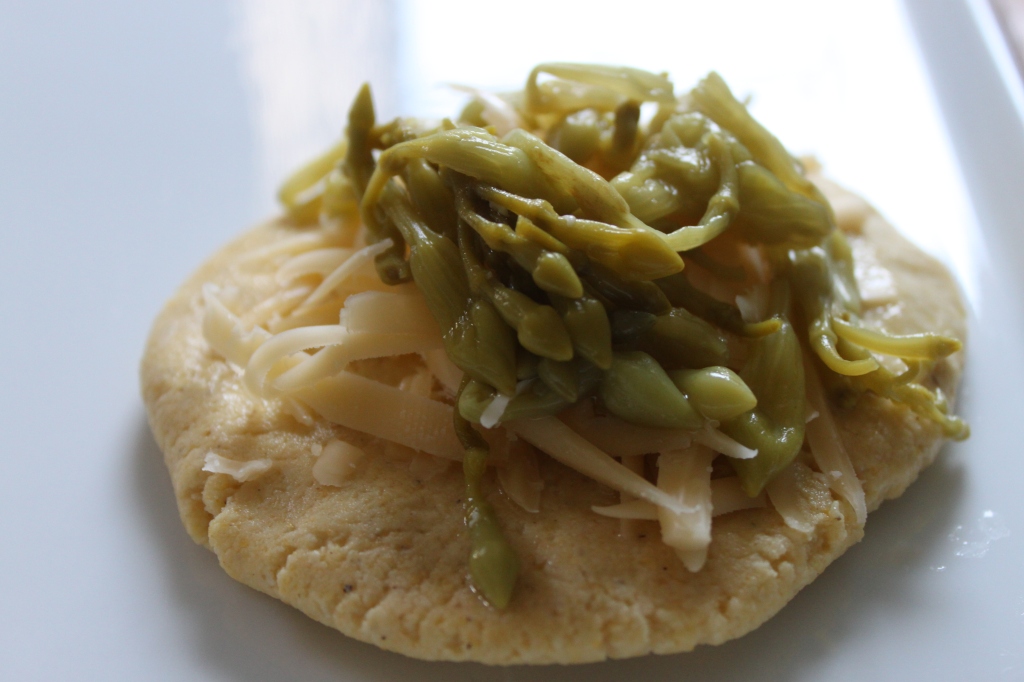 Loroco is native to Central America, and was
called Quilite, which in the indigenous language means “Edible herb”. It
is a perennial plant that produces flowers from May to October in El
Salvador, but with irrigation can produce year-round. The Loroco plant
is a tropical flowering woody vine with ornamental flowers. It grows
wild in El Salvador, Guatemala, Honduras, and Nicaragua, and prefers a
temperature range between 68 and 90 F.
Loroco is native to Central America, and was
called Quilite, which in the indigenous language means “Edible herb”. It
is a perennial plant that produces flowers from May to October in El
Salvador, but with irrigation can produce year-round. The Loroco plant
is a tropical flowering woody vine with ornamental flowers. It grows
wild in El Salvador, Guatemala, Honduras, and Nicaragua, and prefers a
temperature range between 68 and 90 F.
The flowers are harvested and used in the cuisine of El Salvador and
some other countries in Central America. It has a unique, pungent flavor
that is used in 'pupusas', a corn-based food popular in El Loroco. Loroco tastes "green" with overtones of nuts. The closest taste perhaps
to compare the "green" part to is chard, or a cross between mild
broccoli and squash
Loroco is propagated principally by seed, but can also be propagated by
cuttings. It takes about three to four months from seed to flowering.
The leaves can be 1 1/2 to 8 1/2 inches (4 to 22 cm) long and 1 1/2 to 5
inches (1 1/2 to 12 cm) wide. The vine produces flowers in clusters of
10 to 32, averaging 25 per cluster, that in turn, if unharvested,
produce pods up to 13 inches (34 cm) long. Seeds are very hard to find. Scarce Seeds available here.
.

For its foliage, for its flowers and for its
fruit, this plant from Chile is just full of interest. A very handsome
and vigorous, twining climber, it has very ornamental, dark green,
glossy, leathery leaves (some folk grow it just for this) and bears very
late in the year drooping clusters of very striking and fascinating,
dark chocolate flowers.
The Flowers are followed by equally fascinating, dark purple,
sausage-shaped fruits two or three inches long. The fruits are sweet,
pulpy and edible and are sold in markets in Chile where they are much
appreciated.
Although they will tolerate a temperature as low as 14°F (-10°C), give
it the warmest, most sheltered spot in your garden. A cool unheated
greenhouse will do just as fine.
Seeds....
Common Vegetable Seeds:
Nobody wants to plant dead seeds but just because it’s old doesn’t mean it won’t grow. Some seeds will germinate and grow for up to 5 years after the date they came from the field. And, at the price of quality food plot seed, it’s worth a second look.
It depends upon what kind of seed it is, how it was cared for, and how it was stored. Seed should be kept cool, dry, and clean and protected from pests and insects in some sort of protective container.
Food seeds can be broken into 2 categories: hard seeds and soft seeds. Hard seeds are hard to the touch and generally store quite well. Soft seeds are softer to the touch and typically do not have a hard coating to protect them. They don’t store particularly well even under ideal conditions
The best way to find out if the seed is still good is by testing germination. Testing seed is simple and you will know if you have good seed in a few days. Spread the seed in question on a moist paper towel. Use about a half dozen seeds (depending on size) per square inch.
Moisten and cover the seeds with another paper towel. Cover with saran wrap or place in a zip lock bag to help keep the medium moist. Be sure to establish and maintain contact between the seed and the testing medium you have placed the seeds on. Keep the whole thing moist, warm to the touch, and provide plenty of light. Basically, you are trying to simulate growing conditions and most seeds won’t germinate in soils below 60 degrees.
In a day or two most of the viable seeds will swell, crack open and start sending out roots and shoots. That’s the germination you are looking for. If nothing happens for a week, the seed you are testing is probably dead (unless you have allowed the seeds to dry out, or drown, and die).
This method may not always apply to exotic, tropical and rare type of seeds. Follow special instructions on those.

 Loroco is native to Central America, and was
called Quilite, which in the indigenous language means “Edible herb”. It
is a perennial plant that produces flowers from May to October in El
Salvador, but with irrigation can produce year-round. The Loroco plant
is a tropical flowering woody vine with ornamental flowers. It grows
wild in El Salvador, Guatemala, Honduras, and Nicaragua, and prefers a
temperature range between 68 and 90 F.
Loroco is native to Central America, and was
called Quilite, which in the indigenous language means “Edible herb”. It
is a perennial plant that produces flowers from May to October in El
Salvador, but with irrigation can produce year-round. The Loroco plant
is a tropical flowering woody vine with ornamental flowers. It grows
wild in El Salvador, Guatemala, Honduras, and Nicaragua, and prefers a
temperature range between 68 and 90 F.
















